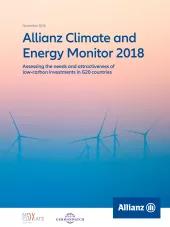The Allianz Climate and Energy Monitor ranks G20 member states on their current attractiveness as potential destinations for investments in low-carbon electricity infrastructure. It further considers their current and future investment needs in line with a trajectory compatible with the 2°C/1.5°C temperature limits of the Paris Agreement.
Key findings:
Renewable energy gusto in emerging markets…
2016 was a year of impressive solar PV installations in the G20. On average, G20 countries installed 50% more solar PV last year than in 2015. New installations for wind decreased by 24%, although from a high level.
Renewable energy expansion was notable in emerging markets in China, India, South Africa, Mexico and Turkey. Growing electricity demand, combined with declining technology costs underpins this boom. Brazil was an exception among these emerging economies, with almost no new solar PV uptake and a modest increase in total wind capacities (23% increase over 2015), the lowest in a decade.
…but OECD countries remain the most attractive destinations for investments due to strong policy frameworks, market experience and positive macroeconomic factors
Germany, UK and France maintain their top positions in the 2017 Monitor. They combine a largely stable and supportive policy environment with highest experience of renewable energies (i.e. market maturity) in the G20 and adequate general investing environment.
France and Germany are the only EU countries to submit long-term greenhouse-gas emission development strategies to the UN so far (till May 2017). A similar long-term policy certainty is lacking in the UK. The UK saw the largest drop in policy attractiveness scores this year, although it maintained its overall attractiveness rank due to continued interest in the renewables industry. UK’s binding renewable energy target ends in 2020 (30% power using renewables) and it is unclear if the government will throw its weight behind renewables and climate change in general after Brexit.
China continues to hold its place in this ‘best-performers club’, maintaining rank four in offering an attractive environment for renewables uptake. With roaring renewable energy markets and consistent policy push, China further improved its renewables track record this year. In fact, it installed more solar photovoltaic (PV) than the rest of the G20 combined in 2016. It is also taking first steps to adjust its power systems and market design for integrating large shares of variable renewables and avoid the huge curtailments seen in the last years.
Turkey, Saudi Arabia and Russia remain at the end of the scale with support for renewables in infancy. Russia and Turkey are the only two G20 countries who have not ratified the Paris Agreement yet, the US has decided to pursue steps to exit the Paris Agreement in June 2017.
High investment needs in the G20, especially in emerging economies
The G20 countries need to roughly double their annual investments to align their power infrastructure with the 2°C pathway set out in the Paris Agreement. The absolute investment needs stand at USD (2012) 709 billion per year between 2014-2035.
The 2016 results highlight again the need for higher investments in emerging economies in the medium term for creating a Paris-Agreement compatible and climate-resilient power infrastructure. India, South Africa and Indonesia emerge as high-need hotspots. They ranked high on all three factors defining investment needs in the Allianz Monitor: increasing demand for energy, sheer size of the country and vulnerability of the existing electricity system to a changing climate.
Countries with currently high emissions in the power sector are projected to have the highest absolute investment needs to be in line with the 2°C goal. These are China, followed by the US and India.
G20 governments are adjusting renewable energy support in response to the renewables boom
In response to expanding renewable energy capacities beyond hydro – renewables have grown on average at 24% annually in the last five years – and falling technology costs, G20 countries are adjusting their support for deployment of renewables-based electricity generation. The general tendency is to move away from fixed fees (“feed-in tariffs”) to auctioning or tendering renewable energy project support.
Over half of the G20 countries are using or announced auctioning in 2016. Yet, care needs to be taken in designing such policies to maintain investor interest. Good practice elements, inter alia, transparent procedures, clear auction frequencies, policy bundling (e.g. with tax breaks etc.), and nesting auctions under long-term renewable energy targets or plans can raise investor confidence on return planning and future demand. Further, economic health and general ease of doing business in a country are critical contributors to successful tendering. These continue to be areas of improvement for many developing and emerging G20 member states, as seen in this year’s assessment.
Almost all G20 countries are pushing climate and renewable action gradually
Many G20 countries took gradual steps for the low-carbon transition of their power sector in 2016. Some countries hold an optimistic outlook for renewables despite lower scores this year. Argentina, ranking 16th this year, is expected to release a new climate strategy towards fulfilling its commitments to the Paris Agreement. Argentina witnessed oversubscribed renewable energy auctions in 2016 but no deployment yet. Both Turkey (rank 18) and Saudi Arabia (rank 19) are expected to go full-steam for meeting their renewable energy targets in 2017 and have announced tenders for large scale wind and solar PV. In a similar way, the Indonesian government is tweaking its renewable energy support policies to ensure procurement by cash-stripped utilities (rank 14).
Falling technology costs will be the tipping point for further renewables growth
2016 also saw renewables growing due to falling technology costs despite cumbersome policy environments in some countries. Most striking example has been the US. Favorable general investment conditions and a ready market mask the increasingly unsupportive federal policy environment and, pulled the US up by two ranks this year (rank 7). Wind and solar alone contributed to 60% of the 27 GW new power installations in the US in 2016, natural gas adding another third (US EIA, 2017). Existing coal power infrastructure is phasing-down in parallel (and due to) the rise of cheaper low-carbon technologies. The US has already announced to pull out of the Paris Agreement and processes have been set in motion to dismantle policies such as the Clean Power Plan (CPP). Market reactions have nevertheless been optimistic about future renewables growth in the US as they are becoming increasingly cost-competitive on their own.
As renewables boom, governments need to start planning for a new power system
As renewables grow, the next wave of policy intervention by governments needs to move beyond targeting low-carbon electricity generation towards system design. With high shares of variable power generation, electricity grids need to be able to balance weather-related peaks. Otherwise, generation needs to be curtailed and potential power supply is lost. The transformation of the power sector requires long-term planning that enhances flexibility in system operations and market design. This will potentially shift trillions in investments and lead to the creation of new market structures. The G20 countries are at the very beginning of this journey.
The discussions around system change are most advanced in Germany, the UK and France. Yet important decisions on long-term expansion of renewables and market structure are still to be taken. The group of countries with no concrete strategy up to 2050 for deep decarbonization of the electricity system and integration of renewables are Argentina, Australia, Indonesia, Russia, Saudi Arabia, South Africa and Turkey.
Without adopting a holistic approach to develop power systems that are flexible for absorbing increasing shares of renewables (through infrastructure development, improved system operations and market design), the ceiling for how much power can be generated from variable renewables will remain. This will affect the speed of the transition and investor confidence in the market.







